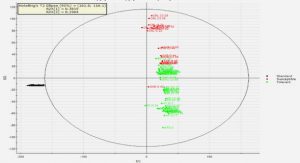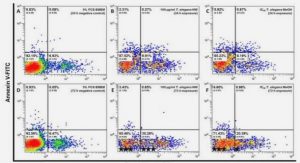Get Complete Project Material File(s) Now! »
Kinetic modelling of oligomerisation over acid catalyst
Kinetic modelling of the reaction rate over SPA focused on the rate of oligomerisation of short chain olefins, these include the work done by Paynter & Schuette (1971), Friedman & Pinder (1971), Cao et al. (1988) and the doctoral thesis of McClean (1987). For other acid catalysts the literature is more prominent (Alcántara et al., 2000; Honkela et al., 2003; Honkela et al.; 2004 Cruz et al., 2007;).
The oligomerisation of short chain olefins over and acid catalyst is mostly with the intent of producing petrol, therefore precautions have been taken to limit the extent of the oligomerisation, especially for the selective production of highly isomerised octenes from iso-butene. Over sulphonic cation exchange resins, the oligomerisation of iso-butene can run away easily to form trimer and tetramer product at mild operating conditions, 100 °C and 94 kPa (Alcántara et al., 2000). Although oligomerisation over a cation exchange resins follows the classical Brønsted mechanism, the increased reaction rate noticed for iso-butene with respect to the rate seen for linear butenes also holds true for SPA (McClean, 1987). Therefore the higher reactivity of skeletal isomers is valid for both traditional Brønsted acids and SPA.
For cation exchange resins, one method which has been used to limit the extent of the oligomerisation is the addition of alcohols to the reactor feed. This limits the oligomerisation to a gasoline-range product and the formation of ethers which is beneficial to the octane of the resulting fuel (Di Girolamo et al., 1997; Cruz et al., 2007; Honkela et al., 2003). The addition of ethers to the gasoline pool has been met with some concern, however, due to the contamination of ground water. For this reason, oxygenates that do not participate in the oligomerisation reaction have been used to limit the extent of oligomerisation, such as tertiary butyl alcohol (TBA) (Honkela et al., 2003; Honkela et al., 2004).
The use of oxygenate compounds as well as branched short chain olefins decreases the amount of possible products by negating the possibility of isomerisation. It is necessary to account for the differences in the adsorption selectivity between the oxygenates and olefins to adequately model the reaction rate. This is done by applying Langmuir-Hinshelwood adsorption to the reaction kinetics, as shown in Equation 2-10 for the dimerisation of isobutene (IB). The reaction network, with regard to the amount of possible dimer products, grows considerably for the oligomerisation of a C5 olefin, Figure 2-16. To simplify the reaction network, lumping of the products and reagents ensues. This simplifies the modelling of the reaction network for C5 oligomerisation. If however a more thorough depiction of the reaction products is needed, especially when the fuel properties are highly sensitive to the composition of the product, a more complicated reaction network will result. Such is the case when modelling the rate of oligomerisation for methyl-butene, where 11 reaction constants are needed to describe the reaction network (Cruz et al., 2007). Validating each of the kinetic parameters would require a great deal of experimental work with a detailed analysis of the product, which is not always a viable option. For instance, if the reaction network was rather completed for 1-pentene, skeletal isomerisation would need to be incorporated in the reaction route, as well as the dimerisation and co-dimerisation of all the pentene isomers.
Closing remarks
Oligomerisation over SPA has been around since 1935 and extensive work has been done with various feeds over the catalyst. Many of these observations link directly to the reaction rate noticed over SPA. Firstly it has been shown that branched olefins of the same carbon length is more reactive than their linear counterparts, secondly the increased activity of the catalyst has also been noticed where the acids strength of the catalyst has been increased.
Although the articles listing these effects on the reaction rate over SPA are numerous, little has been done to include these effects in predicting the reaction rate over SPA. Where the reaction rate has been modelled (Paynter & Schuette, 1971; McClean, 1987; Coa et al., 1988) these aspects of the oligomerisation over SPA has not been included in the proposed reaction kinetics. Not only has the increased reactivity of branched olefins been ignored when modelling the reaction rate, the propensity of SPA to skeletal isomerisation has also not been included in modelling the reaction progression over SPA.
This thesis investigates the oligomerisation of 1-hexene with regard to the reaction progression from 1-hexene to oligomerised and cracked products over a wide temperature range. Since it has been shown that branched olefins have a higher reactivity over the catalyst, the current research will attempt to incorporate the reactivity differences of linear (1- hexene) and branched olefins (2,3-dimethyl-2-butene) together with skeletal isomerisation in the proposed kinetic model (Chapter 3). The link between activity and acid strength on the reaction rate will be investigated in Chapter 4 by altering the acid content of the catalyst as well as the addition of water to the reaction mixture.
1 Introduction
2 Literature survey
2.1 Oligomerisation: Product slate
2.2 Background: Oligomerisation of short chain olefins over SPA
2.3 Oligomerisation of light naphtha olefins over SPA
2.4 Solid phosphoric acid
2.5 Catalyst hydration
2.6 Reaction mechanism/network
2.7 Kinetic modelling of oligomerisation over acid catalyst
2.8 Closing remarks
3 Reaction Kinetics for 1-Hexene Dimerisation
3.1 Background
3.2 Experimental
3.3 Results & Discussion
3.4 Kinetic model
3.5 Conclusions
4 Effect of Acid Strength on 1-Hexene Dimerisation
4.1 Experimental
4.2 Results and discussion
4.3 Conclusions
5 Product spectrum
5.1 Experimental
5.2 Results and discussion
5.3 Conclusion
6 Conclusions
7 Bibliography






